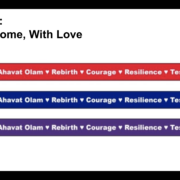Holy at Home, With Love
[youtube https://www.youtube.com/watch?v=jTun5Lk9PfE]
Here’s a recording of my sermon if you’d rather watch it than read it. (It’s here on YouTube.) Or, read below…
Not quite two thousand years ago, the Roman army sacked the second Temple.
That’s a tough place to begin my words to you on erev Rosh Hashanah! But in a way, it’s where tonight’s story begins.
The Temple was the center of our universe. It was our axis mundi, the holy connection point between this world and God.
And then it was destroyed.
Judaism could have ended when the second Temple fell. The Temple was the site of our daily offerings to God. Our whole religious system was built around it! We could have given up hope. That could have been the end of the Jewish people and the Jewish story.
Thank God, it wasn’t. That destruction sparked a paradigm shift in how we “do Jewish.” Jewish life become portable, something we could take with us into every corner of the globe. The center of Jewish life became the synagogue, which aspires to be a beit knesset (house of community gathering), beit midrash (house of study), and beit tefilah (house of prayer) all in one.
And, some would say: the center of Jewish life became the Shabbes table. Tradition teaches that the table where we celebrate Shabbat each week is a mikdash me’aht, a tiny sanctuary. The home table replaces the altar of old; the twin loaves of challah replace the doubled Shabbat offerings on that altar; and holy space becomes… wherever we make it.
Never has that seemed so true to me as it does right now… or as necessary.
Six months ago when we began sheltering-in-place to stop the spread of covid-19, we hoped that a few months of disciplined quarantine would quell the pandemic and that we would be back together again in person by Rosh Hashanah. Instead here we still are: making Rosh Hashanah in our homes, keeping each other safe by staying physically apart.
Our synagogue is still a house of gathering, a house of study, and a house of prayer… and right now all three of those houses are our own houses. Our challenge is learning how to create sacred space here at home where we are. Learning how to create community together when we can’t embrace or sing in harmony. Learning how to find holiness in our everyday spaces, and how to feel community connections even when we’re apart.
It turns out that Judaism has some spiritual technologies designed for exactly these purposes. The Shabbes table is one of them — a white tablecloth, maybe some flowers, the Shabbes candles burning to remind us of the first light of Creation and the light of revelation at Sinai. These are tools for making sacred space.
Another is tzitzit, wearing fringes on the corner of our garments to remind us of the mitzvot — that’s a tool for mindfulness, and for community connection. Our community’s tradition of making bracelets each year serves the same purpose. For several years now we’ve printed silicone bracelets for the Days of Awe. This year’s bracelets read:
Love ♥ Ahavat Olam ♥ Rebirth ♥ Courage ♥ Resilience ♥ Teshuvah ♥
There are two transliterated Hebrew words or phrases. One is teshuvah — repentance, return, turning ourselves in the right direction again. That’s the fundamental move of this season, and that word has been on our bracelets every year we’ve gotten them printed. The other is ahavat olam, a phrase from daily liturgy. It means unending love, or forever love, or eternal love. Our tradition tells us that God loves us with ahavat olam.
For some of us “the G-word” is a stumbling block. Which God, what God, what do we mean by God — God far above, God deep within, Parent, Sovereign, Creator, Beloved? And for some of us “the L-word” might be equally challenging. The word love gets so overused it becomes almost meaningless.
“Wait ’til you hear this song, you’re going to love it!”
Fiddler on the Roof: “Do you love me?” (“Do I what?!”)
My son would tell you that he loves Minecraft and plain vanilla soft-serve. That’s not the same thing I mean when I tell him that I love him.
When I say I love my child, I’m talking about something profound and soul-expanding. If “I love ice cream” is a five on the love scale, maybe “I love my child” is 500… and ahavat olam is infinity. And I think in this pandemic year, we need connection with that sense of infinite ahavat olam more than ever before.
That’s why love — ahavat olam — is our theme for this year’s Days of Awe. And our four cups tonight at our Rosh Hashanah seder represent different facets of love.
The first cup was for creative love. One of my favorite teachings holds that God created the universe of love, because God yearned to be in relationship with us.
Our second cup was for courageous love. Love asks us to risk disappointing each other. To risk speaking difficult truths. To act with courage and integrity, even when we feel as though we’re in the wilderness.
Our third cup just now was for resilient love. In this season of teshuvah, love asks of us the resilience to honestly turn our lives around.
And before Mourner’s Kaddish we’ll bless a cup of tears, evoking love that remembers.
Tonight we’re celebrating Rosh Hashanah while sheltering-in-place. We’re making our home spaces holy, and learning how to feel connected as a community from all the various places where we are. These are actions that we take to protect each other, to prevent viral spread, to care for those who are medically vulnerable and immunocompromised. They’re actions we take out of love.
Our bracelets this year also say rebirth: because tradition says that today the world is reborn, because this season is our chance to begin again. They say resilience, because the new year calls us to resilience; because the pandemic calls us to resilience; because authentic spiritual life calls us to resilience. And they say courage, because starting over takes courage. And living during a pandemic takes courage. And as Brene Brown reminds us, “courage” has its roots in the French word coeur: heart. Courage takes heart. Which brings us back once again to love.
May these Days of Awe strengthen our resilience and our courage and our heart. May they help us find holiness at home, here in all the physical places where we are. And may we emerge from this sacred season more able to give and receive love in all the ways that our world most needs.
L’shanah tovah.
This was R’ Rachel’s brief d’varling from tonight’s Erev Rosh Hashanah Seder (cross-posted to Velveteen Rabbi.)






